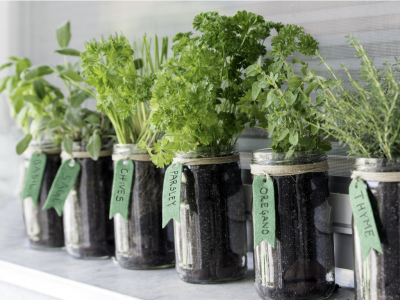
Perfect Plantings for a Windowsill Herb Garden
Want to spice up your meals with fresh herbs even after the summer gardening season ends? Consider adding a windowsill herb garden to your kitchen.
The list of fresh herbs that can be grown outdoors during warm weather months is long. But the options are slim for those that will flourish indoors, where the light is less intense, and the temperatures are cooler.
Here are a few herbs that are better at managing indoor growing conditions. Position them in a kitchen window where they will be easy to care for and even easier to clip and use!
Parsley
Parsley grows well indoors and works well as an herb or a garnish. Vitamin and antioxidant-rich, parsley offers a variety of health benefits, including cancer-fighting flavonoids. The most common types of parsley are French curly-leaf and Italian flat-leaf.
Parsley can easily be incorporated into quiches, sauces, marinades, and fresh salads. Add a little or a lot, depending on your taste. (Note: Cilantro, which looks similar to flat-leaf parsley, does not fare well indoors.)
Tarragon
French tarragon is another indoor winner offering a unique blend of lemon, basil, and licorice flavors and several health benefits.
This popular herb is particularly well-suited for egg, chicken, fish, and vegetable dishes. It’s also used in béarnaise sauce, tomato-based sauces, and can be tossed in fresh salads.
Peppermint
Refreshing peppermint is hearty and grows well wherever it’s planted, making it a perfect indoor herb. It’s an excellent garnish to cool summer drinks and can be frozen in ice cubes for this purpose.
When boiled, peppermint makes an effective stomach-soothing tea. It works in both savory and sweet recipes. You can also brighten the flavor of vegetables by “minting” them.
A peppermint plant can keep your kitchen smelling fresh while also deterring both moths and ants. (Note: If you decide to transplant peppermint outside, it’s a good idea to keep it contained since it can grow like crazy and overtake other plants.)
Chives
Close cousins to onions and garlic, chives are a healthy addition to your cooking that’s easy to grow indoors. It offers a flavor boost to eggs, salads, potatoes, and soups.
Chive’s tiny tubular stems make an attractive garnish, whether used whole on a plate or chopped into circles and sprinkled on food. Although chives are healthy for humans, they are poisonous to dogs and cats.
Pet safety is an essential consideration when growing any indoor herbs since different varieties have varying levels of toxicity to dogs and cats.
Other Options
Other popular herbs like rosemary, oregano, sage, and thyme are harder to grow indoors since they require more light than most windows gardens offer. They’re better options for outdoor summer gardens.
If you prefer the convenience of having these herbs on your windowsill during the summer, try planting two pots of each type. Keep one plant outside and rotate the pots every couple of weeks.
You may also be able to bring summer herbs indoors to “winter over,” but don’t expect them to flourish without a grow light, warm temperatures, and special care.
Sweet basil, another popular herb, will survive briefly indoors but should be grown outdoors for the best results. Some globe-type basil varieties will do better indoors.
Dill, fennel, lemongrass, and bay laurel require abundant outdoor light and space and are not as well suited for “rotation” methods.
